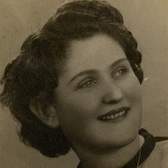
-
Learn More about Anna
Anna Grosz was born Anna Seelfreund on April 20, 1926, in Racşa, Romania, to Samuel and Ilona Seelfreund. Samuel owned a vineyard and was a wine merchant, while Ilona cared for Anna and her five sisters: Margaret, Gisela, Clara, Elizabeth, and Violet.
On August 30, 1940, Axis partners Germany and Italy arbitrated a division of the province of Transylvania between Romania and Hungary. Hungary annexed northern Transylvania, in which Racşa was located. Now under Hungarian rule, the Seelfreund family was subject to the Hungarian government’s antisemitic laws of 1938, 1939, and 1941, which were modeled after the Nuremberg Laws in Germany. At the age of fourteen, Anna was no longer allowed to attend school. Samuel’s vineyard was confiscated and he was conscripted into the Hungarian Labor Service. After receiving a few letters from Samuel, the family heard nothing more from him. Samuel never returned home.
After Nazi Germany occupied Hungary in March 1944, installing a collaborationist Hungarian government, Hungarian officials agreed to turn over hundreds of thousands of Hungarian Jews to the custody of the Germans. Hungarian authorities decreed that all Jews in Hungary wear the Star of David on the front and back of their clothing. Under the orders from the Hungarian gendarmerie, Ilona and her daughters, along with other Jews from the surrounding towns, had to move in May 1944 into the Satu-Mare (Hungarian: Szatmárnémeti) ghetto, a holding pen established the previous month for the purpose of concentrating the Jews of the region for transport to the German Reich. Three weeks later, Hungarian authorities ordered the Jews concentrated at Satu-Mare to take their belongings and report to the train station. Anna was the 92nd person to enter the boxcar that would take them to Auschwitz. Upon arrival in Auschwitz-Birkenau, the SS staff separated the family. The SS selected Anna, Gisela, Clara, and Elizabeth for forced-labor; the girls had their hair cut off and were disinfected. They were then registered as prisoners and assigned to a barrack. Ilona, Margaret, and Violet were sent to the gas chambers, where they were murdered the night of their arrival.
On June 29, 1944, the four remaining sisters were sent to Stutthof concentration camp near Danzig, Germany (today: Gdańsk, Poland), and then in early July to the Praust subcamp with around 500 other female prisoners, to be joined by 300 more in early August. There they built an airport hangar and runway, working in shifts of 50 women at a time. One day, while in the barrack, Anna jumped off the top bunk and broke her leg. Gisela pleaded with a German officer, for whom Anna had often sang Romanian folk songs, to allow them to set Anna’s leg, and a fellow prisoner helped Anna get an assignment sewing civilian clothing for German guards.
On February 11, 1945, the SS evacuated most of the prisoners, including Gisela, Clara, and Elizabeth, marching them on foot north and west of Gdańsk; Soviet troops liberated them around March 11, 1945. Along with the other injured and sick prisoners, Anna was left behind at Praust; they were joined by hundreds of prisoners evacuated from the Organisation Todt camp in East Prussian, escorted by another guard detachment. Dressed in civilian clothes, German personnel destroyed the airstrip and the barracks before they abandoned the labor camp for good. On March 23, 1945, Soviet troops liberated some 600 prisoners, including Anna.
After liberation, Anna returned home where she reunited with Gisela and Clara. Elizabeth was shot and killed while on the evacuation march. In 1947, Anna met Emory Grosz, a survivor from Romania and a grain merchant, and they married two months later. They had two sons. Anna and her family immigrated from communist Romania to New York City in 1964. Emory got a job as a fabric cutter and sample-maker at a garment center, while Anna became a seamstress in a clothing factory, where she worked for 27 years. Anna lived in the Washington, DC, metropolitan area and was a volunteer at the United States Holocaust Memorial Museum.
